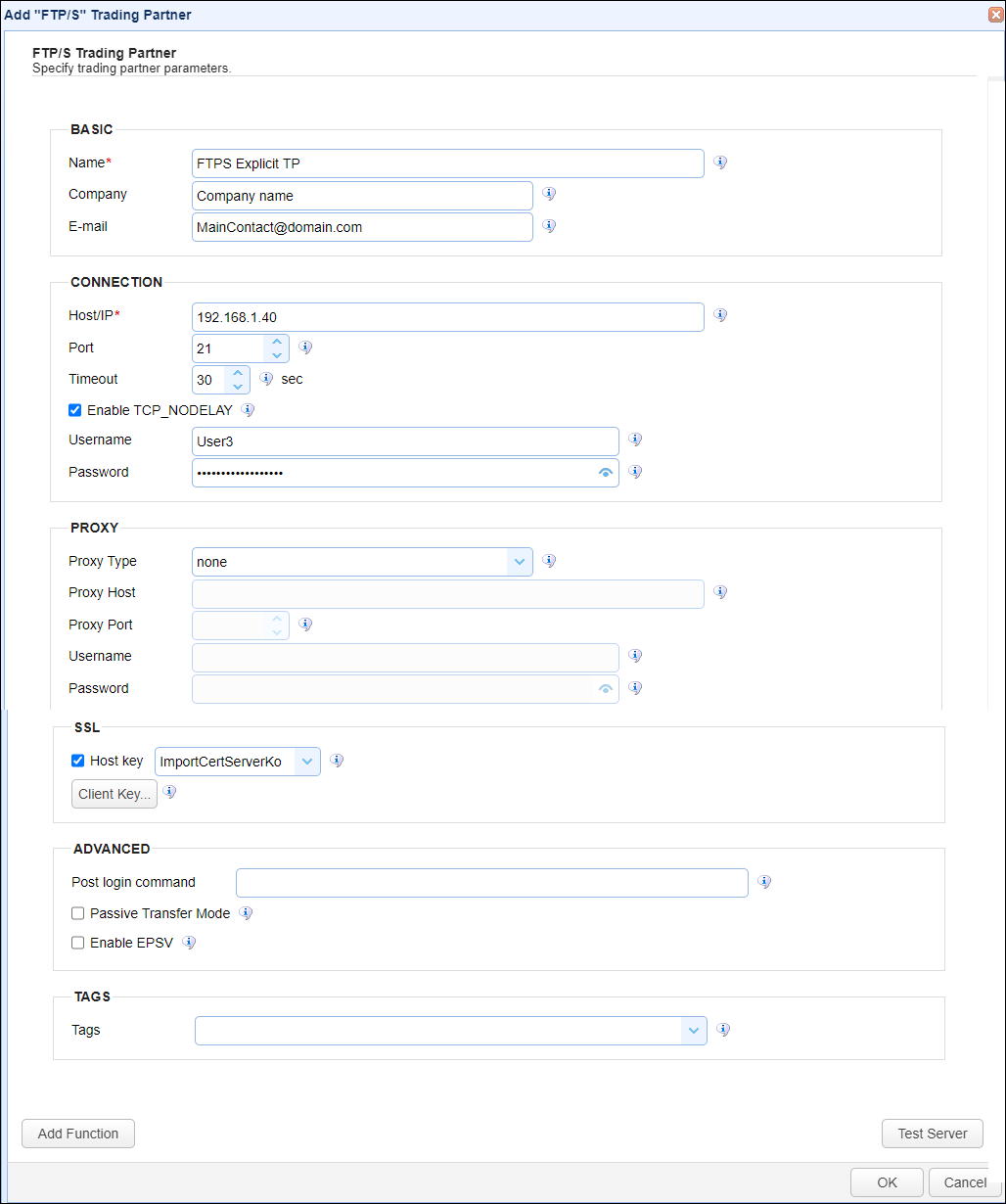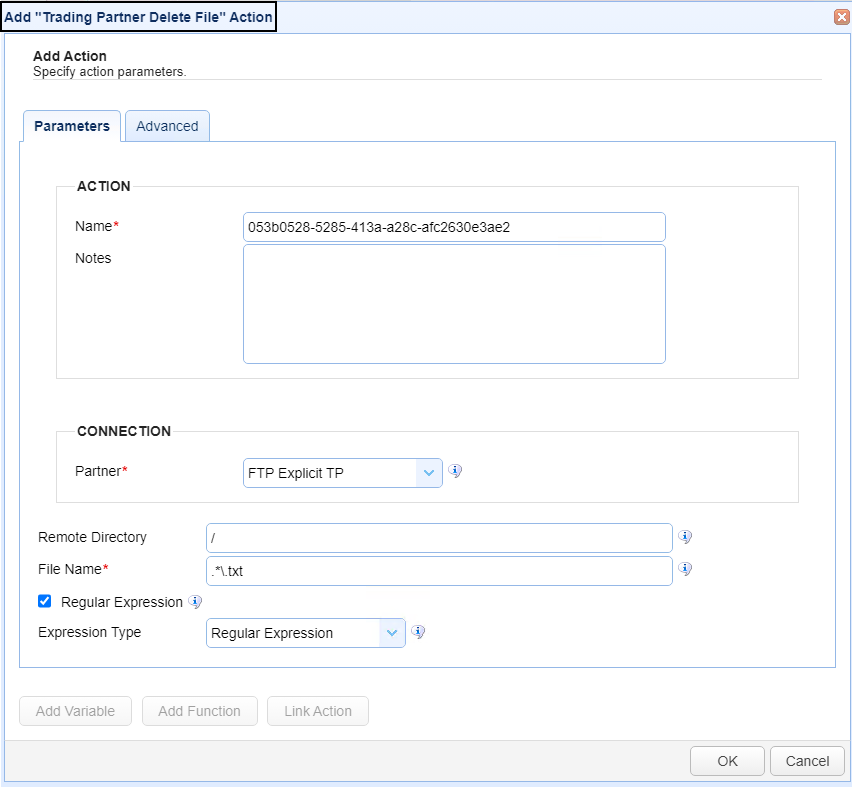FTPS Explicit trading partner
This trading partner exchanges data with a remote FTPS service using the explicit mode. The MFT Server initiates the connection to the remote FTPS service that you configure for this trading partner. It is assumed that the administrator of the remote service has provided you with the details needed to set up the FTPS trading partner - details such as the system's hostname or IP address, port number, username, and password.
Adding the FTPS explicit trading partner
In the desired domain, navigate to the AUTOMATION > Trading Partners module. Click on the Add button, or right click anywhere in the grid area and select Add from the pop-up menu. In the Add Trading Partner dialog window, select FTPS explicit as the Protocol, then click OK. The Add "FTP/S" Trading Partner dialog will appear as depicted in the image below.

Basic
Name - The unique name to assign to this trading partner. Enter a name that best describes the trading partner, as you will be selecting the name when using the partner in MFT Server features that support it.
Company - The name of the company that this trading partner represents.
E-mail - The primary email address for this trading partner.
Connection
Host/IP - The hostname or IP address for the remote FTPS explicit service.
Port - The port number for the remote FTPS explicit service.
Timeout - The maximum timeout (in seconds) for establishing a connection to the remote FTPS service.
Enable TCP_NODELAY - If checked, this setting disables Nagle's algorithm.
Username - The username when logging in to the remote FTPS explicit service.
Password - The password when logging in to the remote FTPS explicit service.
Proxy
This section is for MFT Server customers who have configured a proxy server that the trading partner connection is required to go through.
Proxy Type - The type of proxy service. The options available are in the drop down list. If one is selected you can set the following:
-
Proxy Host - The hostname or IP address of the proxy service.
-
Proxy Port - The port number of the proxy service.
-
Username - The username used when logging in to the proxy service.
-
Password - The password used when logging in to the proxy service.
SSL
Host Key - If checked, this means a certificate is being used to verify the identity of the remote server. The field's dropdown list allows you to select a Host key - managed by the Key Manager. See Key Management. The Host key is the public certificate generated by the administrator of the remote service, then sent to the MFT Server administrator. The certificate can then be imported into the Host Keys grid - on the global-level (Keys > Host Keys) or domain-level (SECURITY > Keys > Host Keys).
Client Key - This key is used to enhance the authentication of the MFT Server (the client) connection to the remote FTPS service. A key pair (where the public key is in the form of a certificate) is used for client authentication. Click the Client Key button, then select the client key type, which consists of the three options described below. Note: The remote FTPS service administrator and the MFT Server administrator are both capable of generating the key pair and providing the appropriate key to the respective party.
-
Use one-time key - If selected, a one-time key is used for authentication. It is generated on-the-fly and discarded after the connection is closed.
-
Use server key - If selected, you will be provided with a dropdown list of Server Keys to choose from - managed by the Key Manager. Typically this option is selected when the MFT Server administrator provides the public key via a certificate to the remote FTPS service administrator. Choosing this option saves time by allowing you to select an already existing certificate. The certificate for the selected Server Key can be exported and sent to the remote FTPS service administrator.
-
Use key file - If selected, this is a file-based key that must be accessible to the MFT Server. For example, C:\PrivateKeyFolder\TradingPartner.prv. Typically this option is selected when the key is already generated by some other application.
-
Key file password - If Use key file type is selected, this is the optional client key password to be used for the connection.
Post login command - Post login command required to control server mode/state. Example: SITE RDW LRECL=80 RECFM=FB TRACKS PRIMARY=10 SECONDARY=5
Passive Transfer Mode - If checked, passive mode will be used when connecting to the remote server.
Enable EPSV - If checked, EPSV (Extended Passive Mode) is enabled.
Tags
Tags - If specified, this is the one or more tags that are used to limit which administrators have access to this trading partner.
Example using the FTPS Explicit trading partner in a trigger action
Triggers are created on the domain-level in AUTOMATION > Triggers. Triggers listen for events (e.g., a file download) and respond with automated actions. There are many trading partner-specific trigger actions. This example does not provide all the steps when creating a trigger; it describes how a trigger action would be configured using the FTPS Explicit trading partner. For a complete discussion about triggers, see Adding triggers.
Assume, when a trigger event occurs, you would like a file to be automatically deleted on the trading partner system.
To accomplish this, you would need to add an action to the trigger, in the Trigger Actions area. The action to add is Trading Partner Delete File as depicted in the image below.

Name - The Name of the Action. The system-generated default value (as depicted in the image above) can be changed to a more user-friendly name, if desired. The Name field can be specified as the input parameter when using the GetActionResult function. For backwards compatibility, the GetActionResult function still supports using the system-assigned Action ID as the input parameter.
Notes - This field is used to describe the action.
Both the Name and Notes fields are displayed as a tooltip when you mouse over an action node in the Trigger Actions canvas area.
Partner - This is the FTPS Explicit trading partner name. A list of existing trading partners will appear in the dropdown list for you to choose from.
Remote Directory - This is the directory name that identifies where to upload the file to on the remote FTPS server. In this example, the home directory for the connecting user (User3 as depicted in the topmost image) will be used.
File Name - This is the regular expression used to identify what files to delete in the Remote Directory. In this example, all the .txt files that reside in User3's home directory will be deleted.